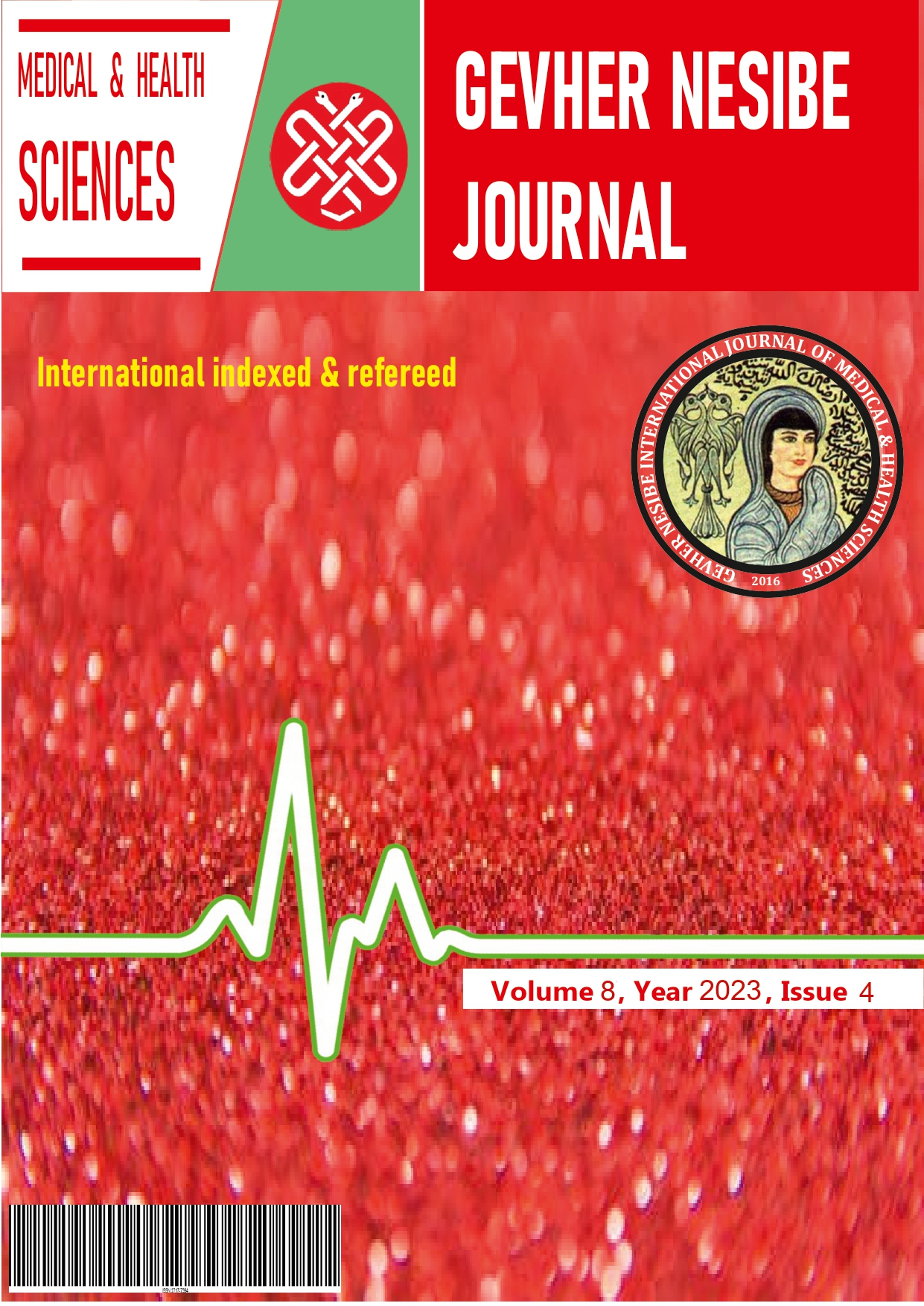Experiences of Operating Room Nurse in Turkey with Cables and Connections Used During the Surgery: A Qualitative Study
DOI:
https://doi.org/10.5281/zenodo.10045637Keywords:
Operating Room Nursing, Optical Fibers, Patient Safety, SafetyAbstract
Objective: This study was conducted in a qualitative type to examine the experience of operating room nurses on cables and connections in the operating room.
Material and Methods: The study was planned in a descriptive phenomenology design, one of the qualitative research types, based on the 32-item qualitative research reporting consolidated criteria checklist, which serves as a guide for qualitative studies. The sample of the study consists of 15 operating room nurses from seven regions of Turkey, determined by the snowball sampling model. Data were collected visually with Microsoft teams application without any time limitation. The data of the research; Data were collected by demographic characteristics form and semi-structured interview form.
Results: The research was carried out with 15 operating room nurses, whose age range was 28-46 years, 9-28 years of professional experience, and all of them were female. In the study, three main themes in the form of how cable safety is ensured, what are the problems experienced when cable safety is provided and solution suggestions, and three sub-themes as personnel injury and personnel safety, patient injury and patient safety and infection risk were obtained.
Conclusion: In line with the data obtained in this study, it was concluded that the operating room nurses had problems with cables and connections, and the laundry clamp used to detect these connections negatively affected patient and employee safety, together with cables and connections.
References
Akkaya, A. ve Karadağ, M.(2021). Ameliyathane Hemşirelerinin Çalışma Ortamından Kaynaklanan Mesleki Risklerinin ve Sağlık Sorunlarının Belirlenmesi. Ege Üniversitesi Hemşirelik Fakültesi Dergisi, 37(1), 11-22.
Castro, CA., Alqassis, A., Smith, S., Ketterl, T., Sun, Y., Ross, S.,… Gitlin, RD.(2012). A wireless robot for networked laparoscopy. IEEE Transactions on Biomedical Engineering, 60(4),930-936. doi: 10.1109/TBME.2012.2232926
Chatzipapas, I., Kathopoulis, N., Protopapas, A., Loutradis, D.(2018). Using a mobile smartphone to perform laparoscopy. Journal of minimally invasive gynecology, 25(5), 912-915. doi: 10.1016/j.jmig.2017.12.027
Courdier, S., Garbin, O., Hummel, M., Thoma, V., Ball, E., Favre, R., Wattiez, A.(2009). Equipment failure: causes and consequences in endoscopic gynecologic surgery. Journal of minimally invasive gynecology, 16(1), 28-33.
Dağcı, M.(2020). Ameliyathane hemşirelerinin delici kesici aletler ile yaralanma durumu, nedenleri ve önlemleri. (Yüksek lisans tezi). İstanbul: Bezmialem Vakıf Üniversitesi. (ET.17.04.2021).(Erişim Adresi: https://hdl.handle.net/20.500.12645/18233).
Haynes, J., Bowers, K., Young, R., Sanders, T., Schultz, KE. (2015). Managing Spaghetti Syndrome in Critical Care With a Novel Device: A Nursing Perspective. Critical Care Nurse, 35(6), 38-45. doi: 10.4037/ccn2015321.
Hergül, FK., Özbayır, T., Gök F.(2016). Ameliyathanede hasta güvenliği: Sistematik derleme. Pamukkale Tıp Dergisi,(1),87-98. doi: 10.5505/ptd.2016.32656.
Imhoff, M.(2004). The Spaghetti Syndrome Revisited. Anesthesia & Analgesia, 98(3), 566-568. doi: 10.1213/01.ANE.0000097187.37014.64.
Kapıkıran, G., Bülbüloğlu, S., Eti Aslan, F.(2018). Ameliyathanede hasta güvenliği, hasta güvenliği kültürü, medikal hatalar ve istenmeyen olaylar. Journal of Health and Nursing Management, 5(2), 132-140. doi:10.5222/SHYD.2018.132.
Kasimi, TB.(2014). Laparoskopik Aletlerin Kullanıma Doğru Hazırlanması. Endoüroloji Bülteni, 7, 18-21. doi: 10.5350/ENDO2014070106.
Koneczny, S. ve Matern, U. (2006).Combining Checklists and Staff Surveys-A Powerfull Tool to Evaluate Operating Rooms. In Proceedings of the Human Factors and Ergonomics Society 50th Annual Meeting; Los Angeles, CA: SAGE Publications, (50)7, 834-837.
Lebni, JY., Azar, FE, Sharma, M., Zangeneh, A., Kianipour, N., Azizi, SA,… Ziapour, A.(2021). Factors Affecting Occupational Hazards among Operating Room Personnel at Hospitals Affiliatedin in Western Iran: A Cross-Sectional Study. Journal of Public Health, 1225-1232. doi: https://doi.org/10.1007/s10389-019-01169-y.
Ofek, E., Pizov, R., Bitterman, N.(2006). From a radial operating theatre to a self‐contained operating table. Anaesthesia, 61(6), 548-552. doi:10.1111/j.1365-2044.2006.04622.
Otlamaz, İ.(2019). Ameliyathanede çalışan cerrahi hemşirelerin teknolojik cihazları kullanma konusundaki becerilerin değerlendirilmesi. (Yüksek lisans tezi). Konya: Selçuk Üniversitesi.(ET.6.04.2021). (Erişim Adresi: https://tez.yok.gov.tr/UlusalTezMerkezi/tezDetay.jsp?id=PkH4BnVsNnbQqFp98d91QA&no=LNFFgfrTSUByaq3wZLOIgg).
Özbayır, T.(2021). Ameliyat Dönemi Bakım. A Karadakovan & F Eti Aslan (Ed.), Dahili ve Cerrahi Hastalıklarda Bakım(s. 259-297). Ankara: Akademisyen Kitabevi.
Özer, N.(2017). Cerrahi Kavramlar; Cerrahi ve Cerrahi Hemşireliğinin Tarihçesi Cerrahinin Sınıflandırılması Cerrahi Gerektiren Durumlar ve Hasta Üzerindeki Etkileri. F Eti Aslan (Ed.), Cerrahi Bakım Vaka Analizleri ile Birlikte(s.3-38). Ankara: Akademisyen Kitabevi.
Paksuniemi, M., Sorvoja, H., Alasaarela, E., Myllyla, R.(2006). Wireless sensor and data transmission needs and technologies for patient monitoring in the operating room and intensive care unit. 2005 IEEE Engineering in Medicine and Biology 27th Annual Conference; 2006 Jan 17-18; Shanghai, China: IEEE, 5182-5185. doi: 10.1109/IEMBS.2005.1615645.
Steelman, VM., Graling, PR., Perkhounkova, Y.(2013). Priority patient safety issues identified by perioperative nurses. AORN journal, 97(4),402-418. doi:https://doi.org/10.1016/j.aorn.2012.06.016.
Downloads
Published
How to Cite
Issue
Section
License
Copyright (c) 2023 GEVHER NESIBE JOURNAL OF MEDICAL AND HEALTH SCIENCES

This work is licensed under a Creative Commons Attribution-NonCommercial 4.0 International License.


